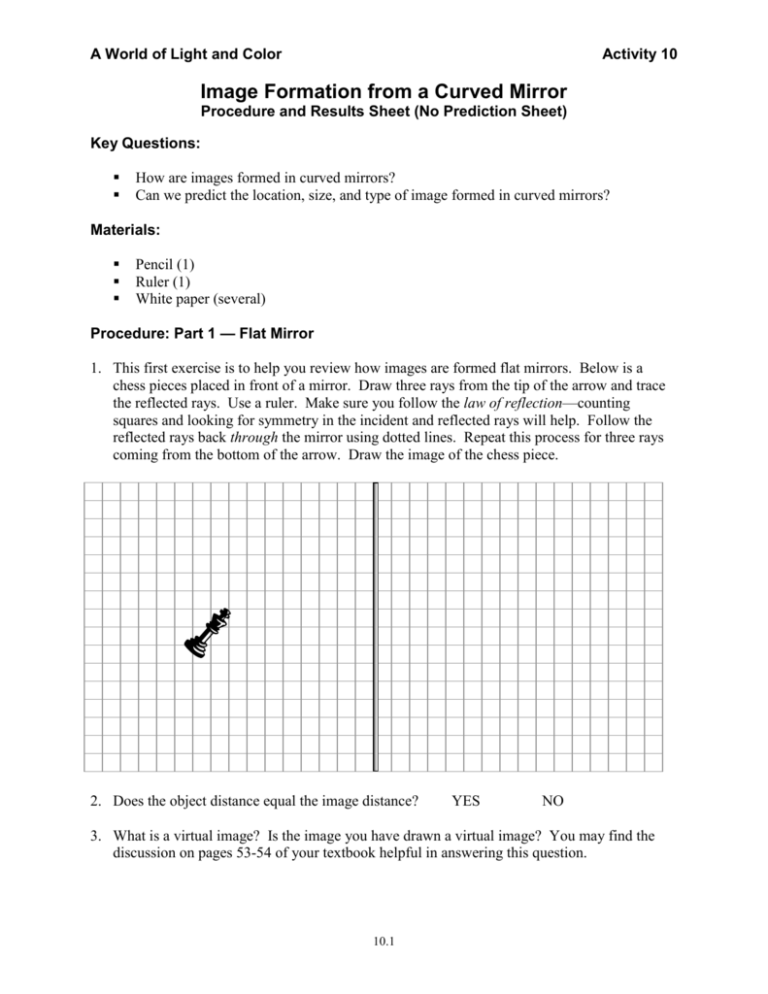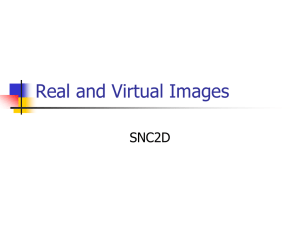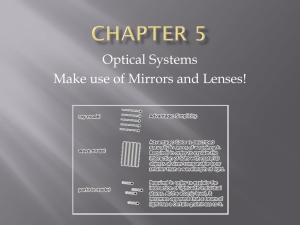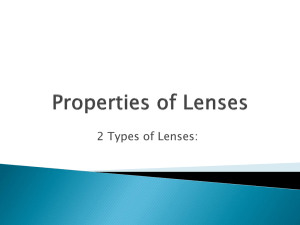Activity 10: Image Formation From a Curved Mirror
advertisement

A World of Light and Color Activity 10 Image Formation from a Curved Mirror Procedure and Results Sheet (No Prediction Sheet) Key Questions: How are images formed in curved mirrors? Can we predict the location, size, and type of image formed in curved mirrors? Materials: Pencil (1) Ruler (1) White paper (several) Procedure: Part 1 — Flat Mirror 1. This first exercise is to help you review how images are formed flat mirrors. Below is a chess pieces placed in front of a mirror. Draw three rays from the tip of the arrow and trace the reflected rays. Use a ruler. Make sure you follow the law of reflection—counting squares and looking for symmetry in the incident and reflected rays will help. Follow the reflected rays back through the mirror using dotted lines. Repeat this process for three rays coming from the bottom of the arrow. Draw the image of the chess piece. 2. Does the object distance equal the image distance? YES NO 3. What is a virtual image? Is the image you have drawn a virtual image? You may find the discussion on pages 53-54 of your textbook helpful in answering this question. 10.1 Part 2 — Convex Mirror 1. In the mirror shown below, mark the center (C ) , the focal point F and the vertex (V ) with dots. The vertex V is in the middle of the curved surface of the mirror, and the center C is located 12 blocks to the right of V. How many blocks long is the radius of curvature (R ) of the spherical mirror? _____ The focal point (F ) of the mirror located 6 blocks to the right of the vertex. How many blocks long is the focal length (f ) of the spherical mirror? _____ Write an equation relating f and R _________________ 2. A line that contains the vertex, center, and focal point is called the optical axis. Draw and label the optical axis on the diagram below. 3. Rays that are near the optical axis are called paraxial rays. There are three special paraxial rays called principal rays. Principal rays An incident ray that is parallel to the optical axis reflects as if it is originating from the focal point. An incident ray that moves towards the center reflects back on itself. An incident ray that moves towards the focal point reflects parallel to the optical axis. The first incident ray that is parallel to the optical axis is already shown below. Draw all three principal rays below and their corresponding reflected rays. 10.2 4. Use the ray tracing rules to locate the image of the chess piece. If the rays do not seem to converge to the same point (but seem to diverge instead), extrapolate the rays to form an image. Notice that we only need to draw two of the principal rays in order to find the image of any point; you can choose any 2 of the 3 principal rays discussed above. Draw two rays from the top of the chess piece, then find their intersection point. This will be the image of the top of the chess piece. Repeat for two rays from the bottom of the chess piece. 5. Answer the following questions. (a) Is the image reduced or magnified? ____________ (b) Is the image upright or inverted? ____________ (c) What is the magnification? ____________ 1 1 1 d o di f object distance is do Mirror equation Magnification equation m d imageheight i objectheight do image distance is di 6. Verify that the mirror and magnification equations are valid by using numbers from your picture. 10.3 7. Now consider a situation where the chess piece is located above the optical axis of the mirror. Draw at least two rays from the top of the chess piece to locate the top of the image. Draw at least two rays from the bottom of the chess piece to locate the bottom of the image. Connect the top and bottom points of the image. What do you notice about your image? 8. Now consider a situation where the chess piece is located below the optical axis of the mirror.What do you notice about your image? Part 3 — Concave Mirror 10.4 1. In the CONCAVE mirror shown below, mark the center (C ) , the focal point F and the vertex (V ) with dots. The vertex V is in the middle of the curved surface of the mirror, and the center C is located 12 blocks to the LEFT of V. How many blocks long is the radius of curvature (R ) of the spherical mirror? _____ The focal point (F ) of the mirror located 6 blocks to the LEFT of the vertex. How many blocks long is the focal length (f ) of the spherical mirror? _____ Write an equation relating f and R _________________ 2. A line that contains the vertex, center, and focal point is called the optical axis. Draw and label the optical axis on the diagram below. 3. Rays that are near the optical axis are called paraxial rays. There are three special paraxial rays called principal rays. Principal rays An incident ray that is parallel to the optical axis reflects as if it is originating from the focal point. An incident ray that moves towards the center reflects back on itself. An incident ray that moves towards the focal point reflects parallel to the optical axis. The first incident ray that is parallel to the optical axis is already shown below. Draw all three principal rays below and their corresponding reflected rays. 10.5 9. Use the ray tracing rules to locate the image of the chess piece below. If the rays do not seem to converge to the same point (but seem to diverge instead), extrapolate the rays to form an image. Draw two rays from the top of the chess piece, then find their intersection point. This will be the image of the top of the chess piece. Repeat for two rays from the bottom of the chess piece. 10. Answer the following questions. Is the image reduced or magnified? ____________ Is the image upright or inverted? ____________ What is the magnification? ____________ 1 1 1 d o di f object distance is do Mirror equation Magnification equation m d imageheight i objectheight do image distance is di 11. Verify that the mirror and magnification equations are valid by using numbers from your picture. 10.6 12. Now consider a situation where the chess piece is located above the optical axis of the mirror. Draw at least two rays from the top of the chess piece to locate the top of the image. Draw at least two rays from the bottom of the chess piece to locate the bottom of the image. Connect the top and bottom points of the image. What do you notice about your image? 13. Now consider a situation where the chess piece is located below the optical axis of the mirror. What do you notice about your image? 10.7







